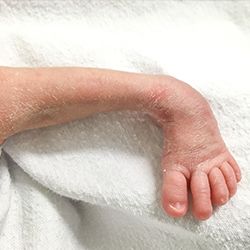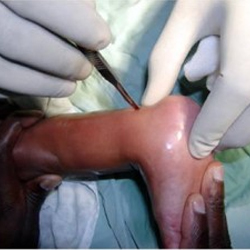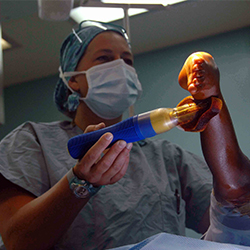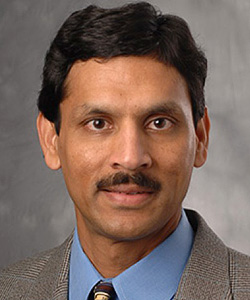Clubfoot: Causes and Treatments Palos Hills and Mokena

Clubfoot is a rare birth defect in which an infant’s foot is turned inward, often so severely that the bottom of the foot is facing upwards or sideways.
There are fewer than 200,000 recorded cases per year in the United States, with boys twice as likely to be diagnosed with the deformity than girls. While most cases of clubfoot are diagnosed at birth, many cases can also initially be detected during a prenatal ultrasound. In about half the cases, both of the infant’s feet are affected.
Clubfoot is not painful during infancy, however, if the problem goes untreated, the affected foot will remained deformed and the child will not be able to walk properly or wear normal shoes. Although, with proper treatment the majority of children experience significant improvement over time and often are able to participate in a wide variety of physical activities.
Classifications
Clubfoot is broadly classified into two categories:
- Isolated: The most common classification for clubfoot in which the deformity occurs in children who do not have other medical problems.
- Non-isolated: A rarer diagnosis in which clubfoot occurs in combination with various other conditions, most commonly arthrogryposis and spina bifida. If classified as non-isolated, the condition may be harder to treat, potentially requiring long periods of nonsurgical treatment and, in some cases, multiple surgeries.
Cause
The cause of clubfoot is still unknown among researchers. The most widely accepted theory is that the condition is caused by a combination of genetic and environmental factors, with an increased risk in families with a history of clubfoot.
Nonsurgical Treatment
The ultimate goal of nonsurgical treatment for clubfoot is a functional, pain-free foot with the sole of the foot facing flat on the ground. There are multiple nonsurgical treatment options available. Currently, The Ponseti Method is the most widely applied treatment program, regardless of the severity of the deformity.
With The Ponseti Treatment, soon after birth long plaster casts running toes to thigh are applied to the affected feet, correctly positioning them. This process is repeated until foot position is largely improved, usually lasting 6-8 weeks.
 After the manipulation and casting period, most babies require a minor procedure releasing tension in the achilles tendon. This is called a tenotomy. The physician will use a thin instrument to cut the tendon (the cut is very small and does not require stitches).
After the manipulation and casting period, most babies require a minor procedure releasing tension in the achilles tendon. This is called a tenotomy. The physician will use a thin instrument to cut the tendon (the cut is very small and does not require stitches).
Following the procedure, a new cast will be applied to the leg to protect the healing tendon, which usually takes about 3 weeks. Once the cast is removed, the heel should be fully healed and the clubfoot largely corrected.
Once the foot has been corrected, most babies are given a brace (also called a “boots and bar”) for a few years to ensure that the foot remains at the proper angle and that a relapse does not occur. This phase of treatment can be demanding for parents, but it is absolutely necessary to prevent recurrence.
Surgery
While many cases of clubfoot are corrected through nonsurgical methods, the deformity may return after initial treatment due to improper following of the treatment program or because the deformity simply won’t respond to stretching. If this is the case, surgical options are available to adjust the tendons, ligaments, and joints in the foot.
Less extensive surgery targets tendons and joints contributing to the deformity. Surgery such as this involves releasing the achilles tendon or moving the tendon that travels from the front of the ankle to the inside of the foot.
 Major reconstructive surgery involves the extensive release of multiple soft tissue structures of the foot.
Major reconstructive surgery involves the extensive release of multiple soft tissue structures of the foot.
Post-surgery, the foot joints are stabilized with pins and a leg cast while the tissue heals, usually lasting four to six weeks.
Once the pins and cast are removed, they are replaced with a short leg cast worn for about four weeks. After that, the patient will be prescribed special shoes, or a brace worn for up to a year after the surgery, to prevent a relapse.
Outcome Expectations
Clubfoot is a rare deformity that should be taken seriously. This condition will not get better on its own, however, through surgical or nonsurgical treatment, your child’s foot may return to relative normalcy. The affected foot is most often 1 to 1.5x smaller and less mobile than its counterpart. Even after treatment, the clubfoot leg will remain smaller, which can lead to sore legs and a lack of stamina. The affected leg may also be slightly shorter than its counterpart.

Dr. Prasad Gourineni
For specialized care, turn to MidAmerica’s Pediatric Orthopaedic Surgeon, Dr. Prasad Gourineni. Dr. Gourineni completed residencies in India and at Northwestern University in Chicago. His specialities lie in hip arthroscopy, ACL reconstruction, Scoliosis, and treating children with clubfoot. Additionally, he has worked in a number Chicagoland Hospitals including Advocate Hope Children's Hospital in Oak Lawn, Children's Memorial Medical Center in Chicago, and Good Samaritan Hospital in Downers Grove.
To learn more about MidAmerica Orthopaedics and the different treatment options available to you, visit our website.
To schedule an appointment with MidAmerica Orthopaedics’ Pediatric Orthopaedic Surgeon, Dr. Prasad Gourineni, call (708) 237-7200.

